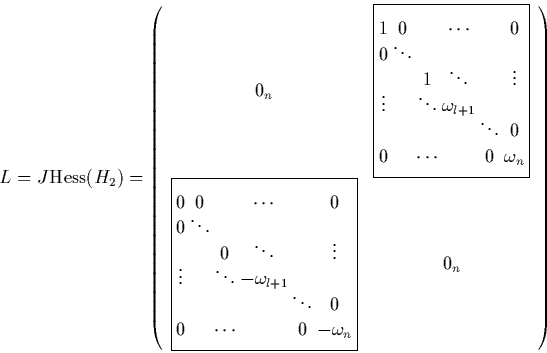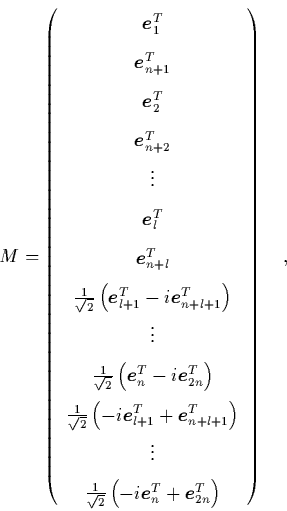![\begin{displaymath}
{\cal A}_m(\cdot) %% = \left\{ \cdot,H_2(\VEC{z}) \right\} ...
...\partial}{\partial z_{n+\nu}}(\cdot)
\right)
\right]_{\L _m}
\end{displaymath}](img239.png)
In this appendix we discuss some details of the transformation of a
Hamiltonian with a quadratic part (34)
into generalized normal form. More
specifically, we show how to simplify the Lie operator
![\begin{displaymath}
{\cal A}_m(\cdot) %% = \left\{ \cdot,H_2(\VEC{z}) \right\} ...
...\partial}{\partial z_{n+\nu}}(\cdot)
\right)
\right]_{\L _m}
\end{displaymath}](img239.png)
The unitary matrix that by a similarity transformation puts the
Hamiltonian matrix


In the new coordinates
![]() the Lie operator takes
on the form
the Lie operator takes
on the form
![\begin{displaymath}
\tilde{{\cal A}}_m
= \left[
\sum_{\nu=1}^l \tilde{z}_{2\n...
...rtial}{\partial\tilde{z}_{n+\nu}}
\right) \right]_{\L _m} \;.
\end{displaymath}](img246.png)
We have not yet
made any assumptions about the ordering of the
monomials
![]() in the basis of
in the basis of ![]() .
If one
chooses the lexicographical ordering [2] of the
basis monomials,
then the
matrix representation of
.
If one
chooses the lexicographical ordering [2] of the
basis monomials,
then the
matrix representation of
![]() becomes an upper diagonal matrix
for all
becomes an upper diagonal matrix
for all ![]() , and all the manipulations of
, and all the manipulations of ![]() that are necessary in the
course of the normalization procedure (solving linear equations, inverting
that are necessary in the
course of the normalization procedure (solving linear equations, inverting
![]() , ...) become easier and consume much less computing time.
, ...) become easier and consume much less computing time.
In the case ![]() it is possible to achieve even further simplification
by an appropriate ordering of the basis monomials of
it is possible to achieve even further simplification
by an appropriate ordering of the basis monomials of ![]() .
One can introduce the so-called magnetic bottle ordering of
monomials which results in
.
One can introduce the so-called magnetic bottle ordering of
monomials which results in
![]() being bidiagonal.
being bidiagonal.